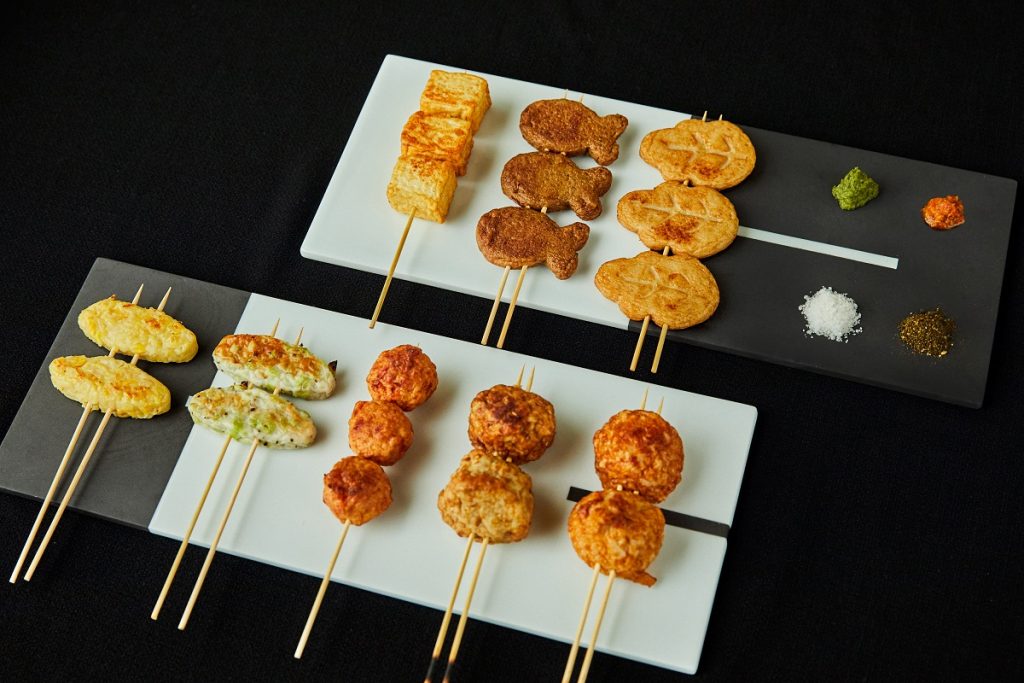The Izakaya experience at Home “Freshly fried with Japanese spices”
The Izakaya can be easily described as a type of informal Japanese pub restaurant. The Japanese izakaya is a traditional place to enjoy the company for friends over prepared dishes and a cup of sake. These establishments are known for their delicious dishes that compliment the lively atmosphere and give patrons a chance to taste the flavors of the area, season, or house specialities. Today we introduce a way to bring that feeling home.
Deep-fried Satsuma-age
Satuma-age is deep fried kamaboko with origins in the southern city of Kagoshima, Japan. When you find satsuma-age on the menu at your favorite bar, you can’t help but order it. After all, freshly fried kamaboko is delicious.
The aroma and flavor of the fish, rice oil, and the crunchy texture of the fish is something that only freshly fried kamaboko can offer. If you can recreate that taste at home, you will also want to serve yourself a cup of good sake to go along with your tasty treat.
I learned that Kamaboko Artist, Kamaboko Mama, roasts bite-sized fried kamaboko called “Okonomi Jusen” to enjoy her evening at home. I asked her about it and she told me, “When you put bite sized kamaboko on bamboo skewers and serve them on a modern ceramic plate, it makes me feel like I’ve come to a fancy Izakaya for a drink.”
The ceramic plate used this time is made by Fukagawa Porcelain in Arita, Saga Prefecture, the hometown of Kamaboko Mama. She likes the contrast between the translucent white and the matte black that expresses the texture of calligraphy ink.
Kamaboko Mama enjoys roasting fried kamaboko on a fish grill or in a toaster oven. It can be eaten as it is, but just heating it up for a few minutes brings back the aroma and crispy texture of freshly fried fish paste, and the charred skin is very fragrant.
What adds to the izakaya atmosphere (Japanese pub) is the neatly arranged condiments. In this case, we used homemade yuzu kosho (yuzu kosho is a chili paste with Yuzu citrus made by Kamaboko Mama), gochujang (Korean red pepper paste), coarse salt, and Yamatsu Tsujita’s top quality shichimi. This shichimi is made from domestic chili peppers, the fantastic Yama Asakura powdered sansho (Japanese mountain pepper), Tanba organic black sesame seeds, yuzu (Japanese citron), and Kochi Itosuji green laver.
Whenever I serve a dish using Yamatsu Tsujita’s Top Quality Shichimi, my friends always ask me, “What shichimi is this? ” I feel like the owner of an izakaya (Japanese style pub) when they see all the condiments I have selected.
Heat it up in a toaster oven for a few minutes to make it freshly fried!
Ingredients
-10 fried kamaboko of your choice
-bamboo skewers
-condiments (yuzu kosho, shichimi, gochujang, grated ginger, etc.)
How to make
1, Heat “Okonomi Jussen” on the grill or in a toaster oven for a few minutes. Be careful, if you overcook it, the kamaboko would be too dry.
2, Pierce with a skewer.
3, Garnish with condiments and serve.
All ten types of the fried Kamaboko “お好み十選 (Okonomi Jussen)” have different textures, flavors, spices and ingredients, such as the fluffy “ふっくらさつま(Fukkura Satsuma)” and the plump “Shrimp Balls.”
We will introduce you to all ten of our favorites at once.
Even if we say “surimi”, the texture and taste are all different, and all ten types are different.
The shrimp ball is filled with shrimp, the fluffy satsuma is like hanpen with yams, and the small fish satsuma is ground with sardines, which gives it a crunchy texture and rich flavor.
The ingredients and spices mixed into the surimi are all unique, so that just one bite is enough to make an impression. It is then fried in rice oil to give it its unique texture.
One bag of Okonomi Jussen starts at 180 yen, so try a variety to find your favorite.
In the photo, the order is from top left to right, then from bottom left to right.
Fukkura Satsuma: Thick fried fish paste made of white fish paste, soybean flour and yam. It is the softest and fluffiest of the ten choices.
Fished shaped Satsuma: White fish surimi mixed with sardine fish meat. Rich flavor of fish with a dense texture.
Shikki Konoha: Plump and supple with a hint of ginger.
Seared Edamame Kamaboko: Edamame with a delightful texture and tangy black pepper accents.
Seared Kamaboko with corn and scallops: The sweetness of corn and the flavor of scallops are packed into this piece.
Shrimp balls: Elegant surimi mixed with shrimp. A delicious combination of the plump texture of the shrimp and the soft surimi.
Negi Maguro: A satisfying bite of tuna and scallions mixed together and deep fried in rice oil. The aroma of scallions and a crunchy texture.
Spicy Cartilage: A spicy fried Kamaboko with the texture of chicken cartilage.
Although not shown in the photo, there are many more items in the “Okonomi Jussen”.
Okonomi: A petite okonomiyaki-like Kamaboko mixed with corn, squid, and green onions.
Gombo: A generous amount of shredded burdock is mixed with surimi.
In addition to Okonomi Jussen, you can also try Agekama, Agetai, and Tairyo Banzai to enjoy the technique of reheating fried Kamaboko.
Profile of Kamaboko Mama
Born into a family of Arita-yaki potters in Arita Town, Saga Prefecture, she grew up surrounded by beautiful pottery. She started making kamaboko lunch boxes for her children, which led her to invent kamaboko decorations and recipes. Currently, she is involved in kamaboko art, and table coordination of kamaboko pinchos and appetizers for reception parties. She is a master of the Edo Kaiseki Kinsa School, a master of the Sogetsu School of Ikebana, and a student of the Japanese painter Suikou Ota.
Cookpad: https://cookpad.com/kitchen/2784459
Instagram: https://www.instagram.com/kamabokomama/
photographs by Hiyori Ikai/ written by Kaeko Liff
